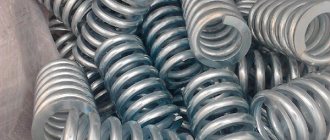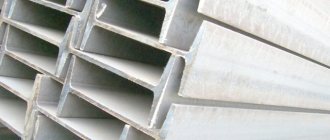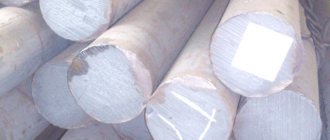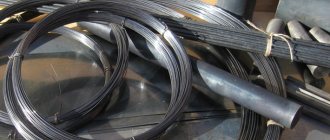GOST 10702-2016 GOST 1050-2013 GOST 19281-2014 GOST R 55374-2012 GOST R 53932-2010 GOST 103-2006 GOST 2879-2006 GOST 2591-2006 GOST 2590-2006 GOST 5950-200 0 GOST 1051-73 GOST 7417-75 GOST 19442-74 GOST 14082-78 GOST 23705-79 GOST 23270-89 GOST 18907-73 GOST 22411-77 GOST 14119-85 GOST 18968-73 GOST 1414-75 GOST 28393-89 GOST 30136-95 GOST 1 6523-97 GOST 19265 -73 GOST R 51285-99 GOST R 52132-2003 GOST R 52544-2006
- gost-30136-95.pdf (329.11 KiB)
GOST 30136-95
GOST 30136–95 (ISO 8457−1-89) Group B22
INTERSTATE STANDARD CARBON STEEL TANK OF ORDINARY QUALITY
Specifications
Carbon steel wire rods of common quality. Specifications
MKS 77.140.60 OKP 09 0200
Date of introduction 1998−01−01
Preface
1 DEVELOPED by the Technical Committee of Ukraine No. 4 “Cast iron, rolled sheets, heat-strengthened long rolled products, products for rolling stock, hardware and consumer goods”; Institute of Ferrous Metallurgy (IFM) INTRODUCED by the State Committee of Ukraine for Standardization, Metrology and Certification
2 ADOPTED by the Interstate Council for Standardization, Metrology and Certification (Minutes No. 8 of October 10, 1995) The following voted for adoption:
| State name | Name of the national standardization body |
| Republic of Belarus | Belstandart |
| The Republic of Kazakhstan | Gosstandart of the Republic of Kazakhstan |
| The Republic of Moldova | Moldovastandard |
| Russian Federation | Gosstandart of Russia |
| The Republic of Tajikistan | Tajikgosstandart |
| Turkmenistan | Main State Inspectorate of Turkmenistan |
| The Republic of Uzbekistan | Uzgosstandart |
| Ukraine | State Standard of Ukraine |
3 This standard corresponds to the international standard ISO 8457−1-89 “Steel wire rod. Part 1. Dimensions and tolerances" in terms of assortment, main parameters and dimensions
4 By Decree of the State Committee of the Russian Federation for Standardization, Metrology and Certification dated May 21, 1997 N 188, the interstate standard GOST 30136–94 was put into effect directly as the state standard of the Russian Federation on January 1, 1998.
5 INTRODUCED FOR THE FIRST TIME
6 REISSUE
1 AREA OF USE
This standard applies to ordinary quality carbon steel rods intended for drawing wire and other purposes.
Brief description of properties
Properties of the material that allow it to be used in many industries:
- Plasticity combined with high strength. This combination of physical properties allows the use of a wide range of mechanical influences for processing, followed by a long service life.
- Low electrical resistance. Only silver is superior to copper in this parameter.
- Low resistance coefficient with increasing metal temperature. At least within the temperature range from 20 to 100⁰С.
Production of copper rod
Copper wire rod is produced using the technology of drawing metal through rolling rollers on special mills, where they make profiled material (wire) of different thicknesses from the wire rod.
When passing through the rollers, the copper rod, which is transformed into wire under their influence, is subjected to strong heating using eddy induction currents or in a gas flame. After passing through the rollers, the hot wire is placed into coils using devices called coilers. At the same time, the material is cooled. In slow-running coilers and on thin wire, such cooling occurs naturally; when quickly winding the finished product, forced air flow is used.
Because of the preheating during the drawing phase, the process is called hot rolling.
Means and methods for testing finished wire
Mandatory check for copper rod:
- Tests according to State Standard 26877 for cross-sectional ovality.
- According to GOST 6507 for deviations from the declared sections. Tools – calipers for large gauges and micrometers (with graduations from 0.01 mm).
- Inspection. In case of minor defects, the surface is cleaned until it is brought to acceptable values.
- Determination of the chemical composition in accordance with GOSTs 31382, 9717, 13938, 27981. If the enterprise has a well-equipped chemical laboratory, it is allowed to study the chemical composition of copper in wire rod using other methods. Not in conflict with existing standards.
- According to GOST 7229 for determining resistance. Equipment – micrometer and high-precision scales.
- Conductivity and elongation test according to GOST 1497.
General information about copper
Copper. The name in the periodic table of elements is Cuprum (Cu). Serial number – 29. Group I or secondary subgroup in the table, in its 4th period. The name comes from the name of the island of Cyprus, from where it was exported to the ancient city-states of the Mediterranean for use in everyday life, on the farm and in war.
In the metallic phase it is a pink-red substance, soft and malleable when heated to 700-800⁰C. Melts at a temperature of 1084.5⁰ C. Can be processed by pressure both cold and hot, as well as all types of soldering and casting into any shape, as well as cutting. After melting, when the melt temperature reaches 2,560⁰С, the liquid metal begins to boil.
The chemical composition of impurities and the method of obtaining the metal also affects such properties of copper as thermal conductivity, specific heat, resistivity and associated electrical conductivity, elasticity, hardness and tensile strength.
Copper grades
The classification of copper in Russia is adopted according to GOST 895-2001 and R-53 803-2010 “Copper. Stamps."
When cathode grades of copper are used in electrically conductive networks or in high-precision equipment, they are often divided into subtypes MooK (cathode) and MooB (oxygen-free), having a purity of 99.99 (the percentage of impurities of foreign substances is 0.001).
The emphasis on oxygen-free copper is not in vain: oxygen in the metal is not only an undesirable oxidizing agent, but also significantly reduces the ductility and strength of the metal. No less harmful is the presence of hydrogen molecules in the atmosphere, which, with significant heat treatment of copper (and not necessarily its melt), diffusely penetrates deep into the metal into its upper boundary layer and reduces copper oxide to pure metal and water. Molecular water, when heated repeatedly, is capable of producing local high pressure in the crystal lattice, which can form breaks, porosity and microcracks in the monolith.
These phenomena are especially harmful if high-temperature soldering or welding of copper surfaces is done, since the strength of the joints is reduced.
Hydrogen disease
However, “hydrogen disease” is typical only for high-temperature welding and soldering. With “soft” soldering, below 400⁰С, the phenomenon of hydrogen embrittlement can be neglected; hydrogen atoms below 400 degrees do not diffuse deeply into the metal - and the more the soldering temperature drops below 400⁰С, the less the influence of this metal reducer from oxides.
To prevent oxidation or the influence of hydrogen, the metal is melted
- In a vacuum.
- In an atmosphere of inert gases (argon).
- Under a layer of charcoal.
Although the most common way to prevent “hydrogen disease” is to introduce into the metal during melting an additive that binds oxygen and does not affect the physical parameters of the metal after casting or broaching. Phosphorus is used as an additive.
The quality criteria used in Russia and the EU countries are almost the same. The difference often lies in the requirements for controlling the quantity and quality of permissible or specially introduced impurities. Thus, Russian M1F and Cu-DHP, although they are analogues, have different impurities. In practice, this is expressed in the fact that in Russia the control of impurities is stricter, and the chemical composition of the metal is more stable in its physical characteristics. In M1F, it is under no circumstances allowed to use scrap during smelting, especially from refined copper fragments. This is the norm in Cu-DHP.
Because of this, conflicts often arise regarding the price of these metals with different degrees of purity - moreover, the price of purer Russian M1F is underestimated at auction when purchasing it from us. And, on the contrary, in reverse transactions it is overestimated for us - which indicates the influence of factors that have nothing to do with the quality or complexity of production.
Strength can be characterized by three states of the same grade: at a tensile strength of 210 MPa, copper is “soft”, at 250 MPa it is semi-hard, and at 280 MPa it is hard. Accordingly, M (foreign analogue of R 220), PT (R 250) and T (R – 280). Although, in addition to T, there are also more durable (solid) states of copper. Copper can even be quenched as a way to increase hardness - to do this, it is heated to 600⁰C and slowly cooled.







